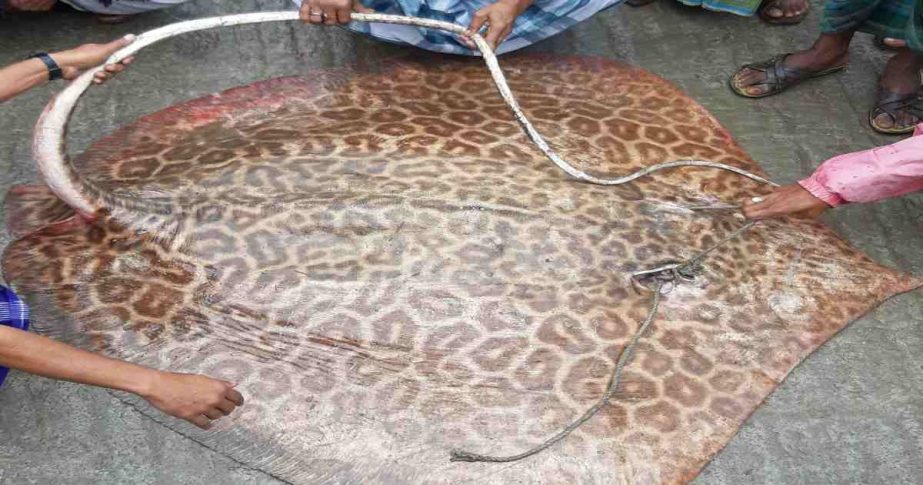
UNB, Bagerhat
The stingrays of the Bay of Bengal, locally known as Shaplapata, are vital for conserving its biodiversity and the marine ecosystem, but it is now endangered due to its lucrative value on the market for the fishing community.
For the last 30 years, Md Rustom Ali Howladar, a fisherman from Porgola village of Pirojpur upazila in Bagerhat, has seen plenty of Shaplapata being captured by fishermen during his ventures to the sea.
“Fishermen usually plant fish-hooks along the seashore to catch the large Shaplapata and smaller ones are often caught easily with fishing nets,” Rustom Ali said.
The high price it fetches at markets in the coastal districts of Bagerhat, Barguna is the reason behind their interest in catching Shaplapata.
Recently, one weighing 400kg was sold for Tk 52,000 at a wholesale fish market in Bagerhat’s KB Bazar through open auction.
Given that the retail price per kg was Tk 300, the fish was sold to consumers at a total price of Tk 1,40,000 minimum, it is said.
“As there is a great demand for Shaplapata in the market and a typical large one can go for Tk 30-40,000 at the wholesale market, they are the big catch but even small ones are sold handsomely,” said some fishermen of the Bagerhat region.
None of them however, would state on the record any specific incident of someone catching a Shaplapata.
You see, the fish is listed as an endangered species by the International Union for Conservation of Nature (IUCN). Thus catching it is a punishable crime, although the law is hardly enforced in its case.
If catching Shaplapata is allowed to continue unabated, Forest Department officials of the Sundarbans fear this majestic fish will soon become extinct, even as the Fisheries Department of the district ponders a ban on all kinds of fishing in the waters it inhabits.
Mohammad Belayet Hossain, divisional forest officer (DFO) of the Sundarbans Eastern Division said, “At least 56 species of Stingrays exist in Bangladesh and some of them weigh 800 Kg. In their 20-25 years life span, the Shaplapata mostly wanders in the deep sea and only comes near shore during the breeding season.”

Reiterating the significance of Shaplapata fish in conserving the marine ecosystem, DFO Belatyet Hossain said,”Buying and selling of this fish is prohibited and a punishable crime. We need to raise awareness among the fishermen, and the law needs to be enforced. Forest Department and Fisheries Department both need to be more alert.”
Stingrays, whose nature gives us the saying ‘sting in the tail’, are an instantly recognisable fish, with their pancake-like bodies that glide gracefully through the water, according to Live Science.
They belong to a class of animals called elasmobranchs, which are characterised by their boneless skeletons made of cartilage. The Stingray’s flat body allows it to sit on the bottom of the ocean, river or lake, camouflaging itself to predators swimming above as it hunts its prey on the floor.
Its eyes sit on the top of its body, while its mouth is on the bottom. Their tails often have a serrated, toxin-filled barb.
Though there are 200 species of Shalpata fish or Stingrays are found across the globe, more or less six of them are frequently spotted in Bangladesh, said ASM Russel, district fisheries officer.
“To allow this endangered fish to propagate safely, all kinds of fishing in the area it wanders in the sea should be banned,” he said.
Meanwhile, Abed Ali, president of Wholesale Fish Market Traders Association in KB Bazar, would only state: “Mostly Shaplapata fish are imported from India and are bought at KB Bazar and then auctioned.”
“Sometimes local fishermen bring Shaplapata to the bazar but the number has declined recently,” he added.

